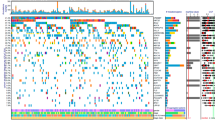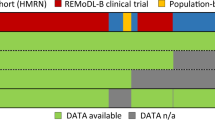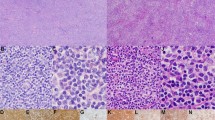Abstract
Follicular lymphoma (FL) is typically an indolent disease, but 30–40% of FL cases transform into an aggressive lymphoma (tFL) with a poor prognosis. To identify the genetic changes that drive this transformation, we sequenced the exomes of 12 cases with paired FL and tFL biopsies and identified 45 recurrently mutated genes in the FL–tFL data set and 39 in the tFL cases. We selected 496 genes of potential importance in transformation and sequenced them in 23 additional tFL cases. Integration of the mutation data with copy-number abnormality (CNA) data provided complementary information. We found recurrent mutations of miR-142, which has not been previously been reported to be mutated in FL/tFL. The genes most frequently mutated in tFL included KMT2D (MLL2), CREBBP, EZH2, BCL2 and MEF2B. Many recurrently mutated genes are involved in epigenetic regulation, the Janus-activated kinase–signal transducer and activator of transcription (STAT) or the nuclear factor-κB pathways, immune surveillance and cell cycle regulation or are TFs involved in B-cell development. Of particular interest are mutations and CNAs affecting S1P-activated pathways through S1PR1 or S1PR2, which likely regulate lymphoma cell migration and survival outside of follicles. Our custom gene enrichment panel provides high depth of coverage for the study of clonal evolution or divergence.
This is a preview of subscription content, access via your institution
Access options
Subscribe to this journal
Receive 12 print issues and online access
$259.00 per year
only $21.58 per issue
Buy this article
- Purchase on Springer Link
- Instant access to full article PDF
Prices may be subject to local taxes which are calculated during checkout




Similar content being viewed by others
References
Kridel R, Sehn LH, Gascoyne RD . Pathogenesis of follicular lymphoma. J Clin Invest 2012; 122: 3424–3431.
Ross CW, Ouillette PD, Saddler CM, Shedden KA, Malek SN . Comprehensive analysis of copy number and allele status identifies multiple chromosome defects underlying follicular lymphoma pathogenesis. Clin Cancer Res 2007; 13: 4777–4785.
d'Amore F, Chan E, Iqbal J, Geng H, Young K, Xiao L et al. Clonal evolution in t(14;18)-positive follicular lymphoma, evidence for multiple common pathways, and frequent parallel clonal evolution. Clin Cancer Res 2008; 14: 7180–7187.
Hoglund M, Sehn L, Connors JM, Gascoyne RD, Siebert R, Sall T et al. Identification of cytogenetic subgroups and karyotypic pathways of clonal evolution in follicular lymphomas. Genes Chromosomes Cancer 2004; 39: 195–204.
Horsman DE, Connors JM, Pantzar T, Gascoyne RD . Analysis of secondary chromosomal alterations in 165 cases of follicular lymphoma with t(14;18). Genes Chromosomes Cancer 2001; 30: 375–382.
Cheung KJ, Delaney A, Ben-Neriah S, Schein J, Lee T, Shah SP et al. High resolution analysis of follicular lymphoma genomes reveals somatic recurrent sites of copy-neutral loss of heterozygosity and copy number alterations that target single genes. Genes Chromosomes Cancer 2010; 49: 669–681.
Bouska A, McKeithan TW, Deffenbacher KE, Lachel C, Wright GW, Iqbal J et al. Genome-wide copy number analyses reveal genomic abnormalities involved in transformation of follicular lymphoma. Blood 2013; 123: 1681–1690.
Bodor C, Grossmann V, Popov N, Okosun J, O'Riain C, Tan K et al. EZH2 mutations are frequent and represent an early event in follicular lymphoma. Blood 2013; 122: 3165–3168.
Green MR, Gentles AJ, Nair RV, Irish JM, Kihira S, Liu CL et al. Hierarchy in somatic mutations arising during genomic evolution and progression of follicular lymphoma. Blood 2013; 121: 1604–1611.
Morin RD, Mendez-Lago M, Mungall AJ, Goya R, Mungall KL, Corbett RD et al. Frequent mutation of histone-modifying genes in non-Hodgkin lymphoma. Nature 2011; 476: 298–303.
Lohr JG, Stojanov P, Lawrence MS, Auclair D, Chapuy B, Sougnez C et al. Discovery and prioritization of somatic mutations in diffuse large B-cell lymphoma (DLBCL) by whole-exome sequencing. Proc Natl Acad Sci USA 2012; 109: 3879–3884.
Pasqualucci L, Trifonov V, Fabbri G, Ma J, Rossi D, Chiarenza A et al. Analysis of the coding genome of diffuse large B-cell lymphoma. Nat Genet 2011; 43: 830–837.
Schmitz R, Young RM, Ceribelli M, Jhavar S, Xiao W, Zhang M et al. Burkitt lymphoma pathogenesis and therapeutic targets from structural and functional genomics. Nature 2012; 490: 116–120.
Okosun J, Bodor C, Wang J, Araf S, Yang CY, Pan C et al. Integrated genomic analysis identifies recurrent mutations and evolution patterns driving the initiation and progression of follicular lymphoma. Nat Genet 2014; 46: 176–181.
Pasqualucci L, Khiabanian H, Fangazio M, Vasishtha M, Messina M, Holmes AB et al. Genetics of follicular lymphoma transformation. Cell Rep 2014; 6: 130–140.
Beguelin W, Popovic R, Teater M, Jiang Y, Bunting KL, Rosen M et al. EZH2 is required for germinal center formation and somatic EZH2 mutations promote lymphoid transformation. Cancer Cell 2013; 23: 677–692.
Quesada V, Conde L, Villamor N, Ordonez GR, Jares P, Bassaganyas L et al. Exome sequencing identifies recurrent mutations of the splicing factor SF3B1 gene in chronic lymphocytic leukemia. Nat Genet 2012; 44: 47–52.
Wang K, Li M, Hakonarson H . ANNOVAR: functional annotation of genetic variants from high-throughput sequencing data. Nucleic Acids Res 2010; 38: e164.
Yildiz M, Li H, Bernard D, Amin NA, Ouillette P, Jones S et al. Activating STAT6 mutations in follicular lymphoma. Blood 2015; 125: 668–679.
Li H, Kaminski MS, Li Y, Yildiz M, Ouillette P, Jones S et al. Mutations in linker histone genes HIST1H1 B, C, D and E, OCT2 (POU2F2), IRF8 and ARID1A underlying the pathogenesis of follicular lymphoma. Blood 2014; 123: 1487–1498.
Lenz G, Wright G, Dave SS, Xiao W, Powell J, Zhao H et al. Stromal gene signatures in large-B-cell lymphomas. N Engl J Med 2008; 359: 2313–2323.
Wright G, Tan B, Rosenwald A, Hurt EH, Wiestner A, Staudt LM . A gene expression-based method to diagnose clinically distinct subgroups of diffuse large B cell lymphoma. Proc Natl Acad Sci USA 2003; 100: 9991–9996.
Davis RE, Ngo VN, Lenz G, Tolar P, Young RM, Romesser PB et al. Chronic active B-cell-receptor signalling in diffuse large B-cell lymphoma. Nature 2010; 463: 88–92.
Lenz G, Davis RE, Ngo VN, Lam L, George TC, Wright GW et al. Oncogenic CARD11 mutations in human diffuse large B cell lymphoma. Science 2008; 319: 1676–1679.
Lamason RL, McCully RR, Lew SM, Pomerantz JL . Oncogenic CARD11 mutations induce hyperactive signaling by disrupting autoinhibition by the PKC-responsive inhibitory domain. Biochemistry 2010; 49: 8240–8250.
Li S, Yang X, Shao J, Shen Y . Structural insights into the assembly of CARMA1 and BCL10. PLoS One 2012; 7: e42775.
Ngo VN, Young RM, Schmitz R, Jhavar S, Xiao W, Lim KH et al. Oncogenically active MYD88 mutations in human lymphoma. Nature 2011; 470: 115–119.
Schif B, Lennerz JK, Kohler CW, Bentink S, Kreuz M, Melzner I et al. SOCS1 mutation subtypes predict divergent outcomes in diffuse large B-Cell lymphoma (DLBCL) patients. Oncotarget 2013; 4: 35–47.
Landgraf P, Rusu M, Sheridan R, Sewer A, Iovino N, Aravin A et al. A mammalian microRNA expression atlas based on small RNA library sequencing. Cell 2007; 129: 1401–1414.
Kwanhian W, Lenze D, Alles J, Motsch N, Barth S, Doll C et al. MicroRNA-142 is mutated in about 20% of diffuse large B-cell lymphoma. Cancer Med 2012; 1: 141–155.
Ying CY, Dominguez-Sola D, Fabi M, Lorenz IC, Hussein S, Bansal M et al. MEF2B mutations lead to deregulated expression of the oncogene BCL6 in diffuse large B cell lymphoma. Nat Immunol 2013; 14: 1084–1092.
Morin RD, Mungall K, Pleasance E, Mungall AJ, Goya R, Huff RD et al. Mutational and structural analysis of diffuse large B-cell lymphoma using whole-genome sequencing. Blood 2013; 122: 1256–1265.
Muppidi JR, Schmitz R, Green JA, Xiao W, Larsen AB, Braun SE et al. Loss of signalling via Galpha13 in germinal centre B-cell-derived lymphoma. Nature 2014; 516: 254–258.
Green JA, Suzuki K, Cho B, Willison LD, Palmer D, Allen CD et al. The sphingosine 1-phosphate receptor S1P(2) maintains the homeostasis of germinal center B cells and promotes niche confinement. Nat Immunol 2011; 12: 672–680.
Guo S, Chan JK, Iqbal J, McKeithan T, Fu K, Meng B et al. EZH2 mutations in follicular lymphoma from different ethnic groups and associated gene expression alterations. Clin Cancer Res 2014; 20: 3078–3086.
Morin RD, Johnson NA, Severson TM, Mungall AJ, An J, Goya R et al. Somatic mutations altering EZH2 (Tyr641) in follicular and diffuse large B-cell lymphomas of germinal-center origin. Nat Genet 2010; 42: 181–185.
Ryan RJ, Nitta M, Borger D, Zukerberg LR, Ferry JA, Harris NL et al. EZH2 codon 641 mutations are common in BCL2-rearranged germinal center B cell lymphomas. PLoS One 2011; 6: e28585.
Lenz G, Wright GW, Emre NC, Kohlhammer H, Dave SS, Davis RE et al. Molecular subtypes of diffuse large B-cell lymphoma arise by distinct genetic pathways. Proc Natl Acad Sci USA 2008; 105: 13520–13525.
Koues OI, Kowalewski RA, Chang LW, Pyfrom SC, Schmidt JA, Luo H et al. Enhancer sequence variants and transcription-factor deregulation synergize to construct pathogenic regulatory circuits in B-cell lymphoma. Immunity 2015; 42: 186–198.
Zheng X, Liang Y, He Q, Yao R, Bao W, Bao L et al. Current models of mammalian target of rapamycin complex 1 (mTORC1) activation by growth factors and amino acids. Int J Mol Sci 2014; 15: 20753–20769.
Okosun J, Wolfson RL, Wang J, Araf S, Wilkins L, Castellano BM et al. Recurrent mTORC1-activating RRAGC mutations in follicular lymphoma. Nat Genet 2015; 48: 183–188.
Eyre TA, Collins GP, Goldstone AH, Cwynarski K . Time now to TORC the TORC? New developments in mTOR pathway inhibition in lymphoid malignancies. Br J Haematol 2014; 166: 336–351.
Ding BB, Yu JJ, Yu RY, Mendez LM, Shaknovich R, Zhang Y et al. Constitutively activated STAT3 promotes cell proliferation and survival in the activated B-cell subtype of diffuse large B-cell lymphomas. Blood 2008; 111: 1515–1523.
Vainchenker W, Constantinescu SN . JAK/STAT signaling in hematological malignancies. Oncogene 2013; 32: 2601–2613.
Becker S, Groner B, Muller CW . Three-dimensional structure of the Stat3beta homodimer bound to DNA. Nature 1998; 394: 145–151.
Jerez A, Clemente MJ, Makishima H, Koskela H, Leblanc F, Peng Ng K et al. STAT3 mutations unify the pathogenesis of chronic lymphoproliferative disorders of NK cells and T-cell large granular lymphocyte leukemia. Blood 2012; 120: 3048–3057.
Huang X, Meng B, Iqbal J, Ding BB, Perry AM, Cao W et al. Activation of the STAT3 signaling pathway is associated with poor survival in diffuse large B-cell lymphoma treated with R-CHOP. J Clin Oncol 2013; 31: 4520–4528.
Shain AH, Pollack JR . The spectrum of SWI/SNF mutations, ubiquitous in human cancers. PLoS One 2013; 8: e55119.
Zhao X, Lwin T, Zhang X, Huang A, Wang J, Marquez VE et al. Disruption of the MYC-miRNA-EZH2 loop to suppress aggressive B-cell lymphoma survival and clonogenicity. Leukemia 2013; 27: 2341–2350.
Kuser-Abali G, Alptekin A, Cinar B . Overexpression of MYC and EZH2 cooperates to epigenetically silence MST1 expression. Epigenetics 2014; 9: 634–643.
Zhang X, Zhao X, Fiskus W, Lin J, Lwin T, Rao R et al. Coordinated silencing of MYC-mediated miR-29 by HDAC3 and EZH2 as a therapeutic target of histone modification in aggressive B-cell lymphomas. Cancer Cell 2012; 22: 506–523.
Acknowledgements
This work was supported by the Lymphoma Research Foundation Follicular Lymphoma initiative (to WCC), Lymphoma SPORE P50CA136411-01-(NCI) (to WCC) and a grant for Global Engagement from the University of Nebraska Foundation (to WCC). The University of Nebraska DNA Sequencing Core receives partial support from the NCRR (1S10RR027754-01, 5P20RR016469, RR018788-08) and the National Institute for General Medical Science (NIGMS) (8P20GM103427, GM103471-09). Research reported in this publication was supported in part by the National Cancer Institute of the National Institutes of Health under award number P30CA033572 and included work performed in the Bioinformatics Core. Thanks to Adam Cornish and Robert J Boissy for initial sequencing analysis assistance.
Author information
Authors and Affiliations
Corresponding author
Ethics declarations
Competing interests
The authors declare no conflict of interest.
Additional information
Supplementary Information accompanies this paper on the Leukemia website
Supplementary information
Rights and permissions
About this article
Cite this article
Bouska, A., Zhang, W., Gong, Q. et al. Combined copy number and mutation analysis identifies oncogenic pathways associated with transformation of follicular lymphoma. Leukemia 31, 83–91 (2017). https://doi.org/10.1038/leu.2016.175
Received:
Revised:
Accepted:
Published:
Issue Date:
DOI: https://doi.org/10.1038/leu.2016.175
This article is cited by
-
EZH2 mutations at diagnosis in follicular lymphoma: a promising biomarker to guide frontline treatment
BMC Cancer (2022)
-
Histopathologic, immunophenotypic, and mutational landscape of follicular lymphomas with plasmacytic differentiation
Modern Pathology (2022)
-
CXCR4 in Waldenström’s Macroglobulinema: chances and challenges
Leukemia (2021)
-
TarPan: an easily adaptable targeted sequencing panel viewer for research and clinical use
BMC Bioinformatics (2020)
-
Genomic characterization of diffuse large B-cell lymphoma transformation of nodular lymphocyte-predominant Hodgkin lymphoma
Leukemia (2020)



